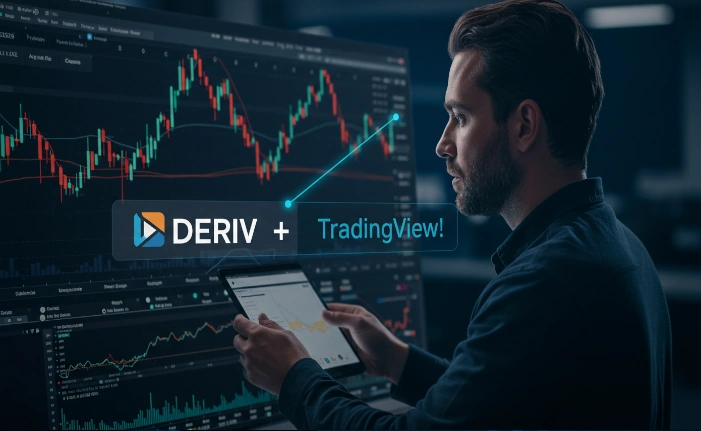Deriv’s TradingView Integration: All You Need to Know
Yesterday, my friend Gabriel who is a brilliant trader, approached me to implement Tradingview indicators into Dervi but even the best gets bogged down by manual coding. That’s why I was excited to help him discover a way to use Devri with TradingView to supercharge his trading experience.
Gabriel isn’t the only one, many traders looking for a powerful combination of charting tools and trade execution might be interested in Deriv’s integration with TradingView. This guide delves into everything you need to know about Deriv’s TradingView implementation, catering to beginners, intermediates, and advanced users alike.

Understanding Integration
So, why should you care about Deriv’s TradingView integration? Here are some compelling benefits that can elevate your trading experience:
- Enhanced Charting: TradingView has carved a niche for itself with its superior charting tools. This integration allows you to leverage these tools for a more comprehensive market analysis directly within the Deriv interface. Imagine having access to a wider range of chart types, indicators, and drawing tools – all at your fingertips while using Deriv for trade execution.
- Streamlined Workflow: With Deriv’s TradingView integration, you can potentially save significant time and effort. Analyze charts, conduct technical studies, and formulate trading strategies – all within the Deriv platform. No more switching between platforms to analyze charts and then execute trades on Deriv. This streamlined workflow allows you to focus on what matters most: making informed trading decisions.
- Familiar Interface: If you’re already comfortable with the intuitive and user-friendly interface of TradingView, this integration offers a familiar charting experience within your existing Deriv brokerage environment. This eliminates the need to learn a new charting platform, allowing you to hit the ground running and focus on mastering your trading strategies.
However, there’s a Catch

While the concept of Deriv’s TradingView integration sounds promising, it’s crucial to understand its limitations before diving in. Here’s a reality check to ensure you have the right expectations:
- Limited Functionality: Don’t expect the full-fledged TradingView experience within Deriv. You likely won’t have access to all the advanced bells and whistles, such as your favorite custom indicators or the ability to code your own strategies using TradingView’s Pine Script. This can be a significant limitation for traders who rely heavily on these advanced features.
-
TradingView Instruments: As of now, the only instrument from Deriv readily available on TradingView is the VIX (volatility index). This means you can’t directly chart all your favorite assets (currencies, commodities, etc.) from Deriv on TradingView. If you primarily trade assets other than the VIX, this integration might not be as beneficial for your specific needs.
-
No Trade Execution: This might be the biggest limitation for many traders. Currently, you cannot execute trades directly from the TradingView charts within Deriv. While you can analyze charts and formulate strategies using the integrated charting tools, you’ll still need to switch back to the Deriv platform to place your trades. This disrupts the streamlined workflow that the integration initially promises.
Beware of Deceptive Solutions
In your quest for a full Deriv and TradingView integration, you might stumble upon YouTube tutorials claiming to offer a “magic bullet” solution. These tutorials often promote downloading a “special cracked version” of TradingView. Here’s a crucial warning: downloading unauthorized software is a major security risk. Not only is it illegal, but it could also have severe consequences. Downloaded software from untrusted sources could expose your financial information or infect your computer with malware, potentially leading to devastating financial losses.
The Bottom Line
While a full-fledged Deriv and TradingView integration isn’t quite there yet, the limited chart functionality offered on Deriv’s platform can still be valuable for some basic analysis. If you’re a beginner trader or someone who primarily focuses on the VIX, this integration can provide a convenient way to analyze charts within your Deriv brokerage environment. However, for intermediate and advanced traders who rely heavily on advanced charting features, custom indicators, and the ability to trade directly from charts, the limitations of this integration might be too significant to overcome.
There might be some third-party tools or scripts out there that claim to offer a more advanced integration experience between Deriv and TradingView. However, it’s crucial to approach these with extreme caution. Before even considering such third-party solutions, here are some essential steps to take:
- Conduct Thorough Research: Don’t simply trust everything you see on the internet. Before trying any third-party tool, delve deep into its functionality, reputation, and potential security risks. Look for reviews from reputable sources and within the trading community.
- Prioritize Security: Security should be your top priority when dealing with your finances. Only consider tools from well-established developers with a proven track record of security.
- Understand the Risks: Even reputable third-party solutions might introduce additional risks. These tools might malfunction, causing missed trading opportunities or losses. There’s also the possibility of compatibility issues arising between the tool, Deriv, and TradingView.
If Deriv’s limited integration doesn’t meet your needs, explore brokers that offer a more comprehensive TradingView integration. This might allow you to leverage the full spectrum of TradingView’s charting functionalities and potentially even execute trades directly from the charts.
Here are Tradingview Brokers to explore:

